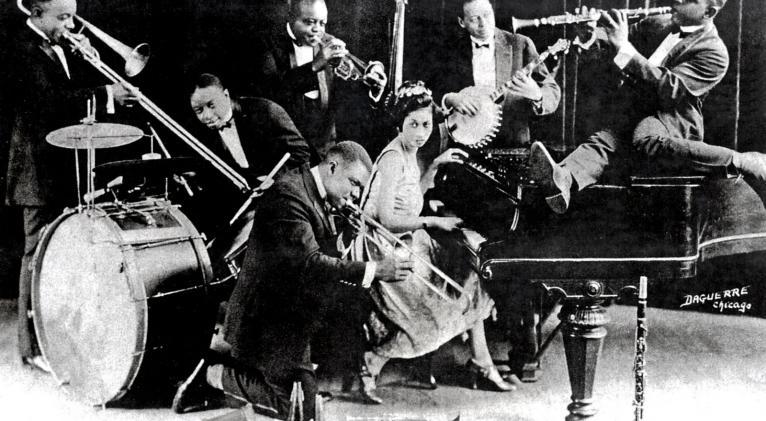Jazz is revolution

At the end of the 19th century, jazz emerged as a musical genre. It occurred in the African-American communities of New Orleans, Louisiana, in United States, where segregation and racial discrimination were predominant for a long time. It was commonly described as “black music,” when it was actually a mixture of races.
The fact is that jazz was born as an African-American and European heritage. In the beginning, it was the slaves with their songs full of rituals and traditions with a high content of improvisation, freedom of creation. It is often regarded as a musical language of its own.
As with anything new, they tried to mutilate it. At its very beginning, it was annoying, perhaps, because the dominant majorities always want to impose themselves and subdue, and in this case it meant rebellion, melodies that they did not understand and feared. Therefore, it was banned, and they had to adapt to censorship, incorporating it from religious music. It then spread to other regions, and the white population was drawn by its charms.
Coming from African rites, related to musical expressions of work and daily life, and based on the blues, the so-called black spiritual, and ragtime, experts refer to the popular tradition of jazz, because of its roots, but they emphasize that it has a language that can be as complex as that of academic music.
Like any process of acceptance, it took years for it to be well regarded. It was not until approximately the 1930s, when it began to be a recognized genre for the highest classes, until then it was thought of as music for blacks, the poor and marginalized.
During all this time jazz evolved, and still continues to develop by incorporating modes, and nourishing itself from its surroundings by taking elements from other genres, whether electronic, hip-hop or funk, to classical, rock, flamenco, and Latin music.
It is often superficially considered simple, and because it is so improvised without a mandatory score, it lacks order and depth. But contrary to this unfounded thought, we are talking about a music that overflows with instinct and talent. It feeds on the imagination. It is all intensity in the performance through a variety of instruments. However, this is not schematic either, jazz can be made without so much ensemble.
Usually saxophone, trumpet, tuba, trombone, clarinet, double bass, drums, piano, and voice are used, although also violin, organ and flute, among many others. Jazz does not have a concrete form. It is not determined by an artifact but by the person who handles it, by how it is played, by the skill to create music from it.
Its essence is to play, to experiment, to be diverse. It is an innovative genre, sometimes faster, visceral and frenzy, sometimes calm, all feelings, melodic and sensual. Jazz is a cultural expression that inspires, entices, and stands out for its spectacular solos with great individual performances.
It has many subgenres that marked eras. Some of them are swing, bebop, cool jazz, hard bop, free jazz, acid jazz, and jazz fusion. There are also many exponents. From the immense list, and according to personal taste, we highlight Buddy Bolden, Ella Fitzgerald, Dizzy Gillespie, Miles Davis, Louis Armstrong, Charlie Parker, Aretha Franklin, as well as Marcus Miller, Nora Jones, Bebo Valdés, Bobby Carcassés, and Arturo Sandoval.
The most interesting thing about it is that it is difficult to characterize it, to pigeonhole it into a closed concept because it has a complex identity. If there is one thing that is common, it is that jazz seeks to find its own, distinctive, unique sound with each performance. The free and variable phrasing in its execution is distinguished.
Jazz breaks with all schemes. It is liberation, musical revolution, unpredictable. It blends in so well with current events that it mirrors its time by incorporating fashionable rhythms in a masterful way with marked originality. That is its essence, what made it grow, become universal, cross borders to become a worldwide phenomenon.
Our showman, Bobby Carcasés, founder of the renowned festival broadly known as the Jazz Plaza, said in an interview we released in 2017:
“The young jazz movement in Cuba can be seen through the achievements of Jojazz, where the true Cuban talents are revealed, parallel to the talents that exist in the sport such as Stevenson, Juantorena, Sotomayor, Ana Fidelia, natural talents born in Cuba, and the same thing happens in music, we just have to look for them: Bola de Nieve, Rita Montaner, Lecuona, Caturla, Roldán, Benny Moré, in short..., and likewise, those talents are seen in instruments and singing too. There are jazz singers like Zule Guerra, for example, who comes out of that movement, and César López, Yasek Manzano, Michel Herrera, and I can tell you that from all the countries in the world, all the people who come here are surprised by the quality of Cuban musicians, because the Cuban musician is trained in art schools with nothing more than symphonic music, concert music and classical music, he studies jazz and does not study Cuban popular music, however, he masters it at the same time perfectly, because that already comes in the blood and is felt by the people who see us abroad.”
Translated by Sergio A. Paneque Díaz / CubaSí Translation Staff














Add new comment